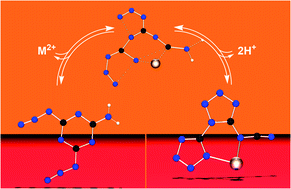Transition-metal-mediated reduction and reversible double-cyclization of cyanuric triazide to an asymmetric bitetrazolate involving cleavage of the six-membered aromatic ring†
Abstract
Cyanuric triazide reacts with several transition metal precursors, extruding one equivalent of N2 and reducing the putative diazidotriazeneylnitrene species by two electrons, which rearranges to N-(1′H-[1,5′-bitetrazol]-5-yl)methanediiminate (biTzI2−) dianionic ligand, which ligates the metal and dimerizes, and is isolated from pyridine as [M(biTzI)]2Py6 (M = Mn, Fe, Zn, Cu, Ni). Reagent scope, product analysis, and quantum chemical calculations were combined to elucidate the mechanism of formation as a two-electron reduction preceding ligand rearrangement.



 Please wait while we load your content...
Please wait while we load your content...